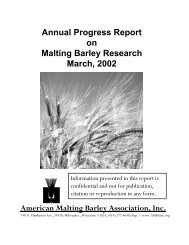Annual Progress Report on Malting Barley Research March, 2007
Annual Progress Report on Malting Barley Research March, 2007
Annual Progress Report on Malting Barley Research March, 2007
Create successful ePaper yourself
Turn your PDF publications into a flip-book with our unique Google optimized e-Paper software.
derived from the backcross: Strider/88Ab536//88Ab536. STAB 47 and STAB 113 are<br />
doubled haploid lines from the cross of Strider/88Ab536. KAB 50 and KAB 51 and KAB<br />
lines are doubled haploid lines from the cross of Kold/88Ab536.<br />
Quality: Quality data from the 2006 harvest have not been received, due to the<br />
movement of the CCRU to a new facility. Past data <strong>on</strong> the three lines in first year AMBA<br />
Pilot, plus a fourth selecti<strong>on</strong> that will be submitted in <strong>2007</strong>, are summarized in Table 3.<br />
These data show a pattern of lower grain protein (and c<strong>on</strong>sequently lower enzyme<br />
activity) but as is apparent from the pre-screening data from Aberdeen, ID, these<br />
selecti<strong>on</strong>s can achieve high grain protein. It remains to be seen what happens to extract<br />
and enzyme activity at these high levels. An advantage of winter over spring barley will<br />
be nitrogen management opti<strong>on</strong>s. Fall/Spring split applicati<strong>on</strong>s of N will allow for more<br />
precise targeting of protein and enzyme levels.<br />
Agr<strong>on</strong>omics: The selecti<strong>on</strong>s all have high test-weight and a high percentage of<br />
plump seed. The yield potential is truly impressive, as is shown in Table 4. Irrigated<br />
winter barley will save at least <strong>on</strong>e applicati<strong>on</strong> of scarce and expensive water compared<br />
to spring barley grown at the same locati<strong>on</strong>. Disease data, as compared to check<br />
varieties, are shown in Table 5. All selecti<strong>on</strong>s showed excellent stripe rust resistance.<br />
No BYDV symptoms were reported <strong>on</strong> any of the four selecti<strong>on</strong>s at UC Davis nor<br />
observed at Corvallis. The selecti<strong>on</strong>s show a range of reacti<strong>on</strong> to scald under intense<br />
disease pressure at Corvallis – such intense scald levels are usually not observed in<br />
target producti<strong>on</strong> areas.<br />
Winter hardiness: We obtained very useful winter hardiness data from two locati<strong>on</strong>s.<br />
The data <strong>on</strong> selecti<strong>on</strong>s are shown in Table 6 and perspectives <strong>on</strong> the entire germplasm<br />
array are shown in Figure 1. Two features stand out. One is that we have a limited<br />
number of winter x spring cross progeny with good winter hardiness profiles. Since both<br />
the high and low lines are part of the CAP set, we will have complete genotype data <strong>on</strong><br />
this germplasm, allowing new insights into the genetic c<strong>on</strong>trol of winter hardiness. This<br />
should further facilitate the c<strong>on</strong>versi<strong>on</strong> of elite spring malting lines to winter habit.<br />
Sec<strong>on</strong>dly, a set of elite winter lines from Europe was included in the c<strong>on</strong>trolled freeze<br />
tests in Hungary. It is gratifying that our germplasm is competitive with the best<br />
European material.<br />
Advanced, preliminary, and early generati<strong>on</strong> materials<br />
These nurseries, and the numbers of lines therein, are shown in Table 1.<br />
104
















